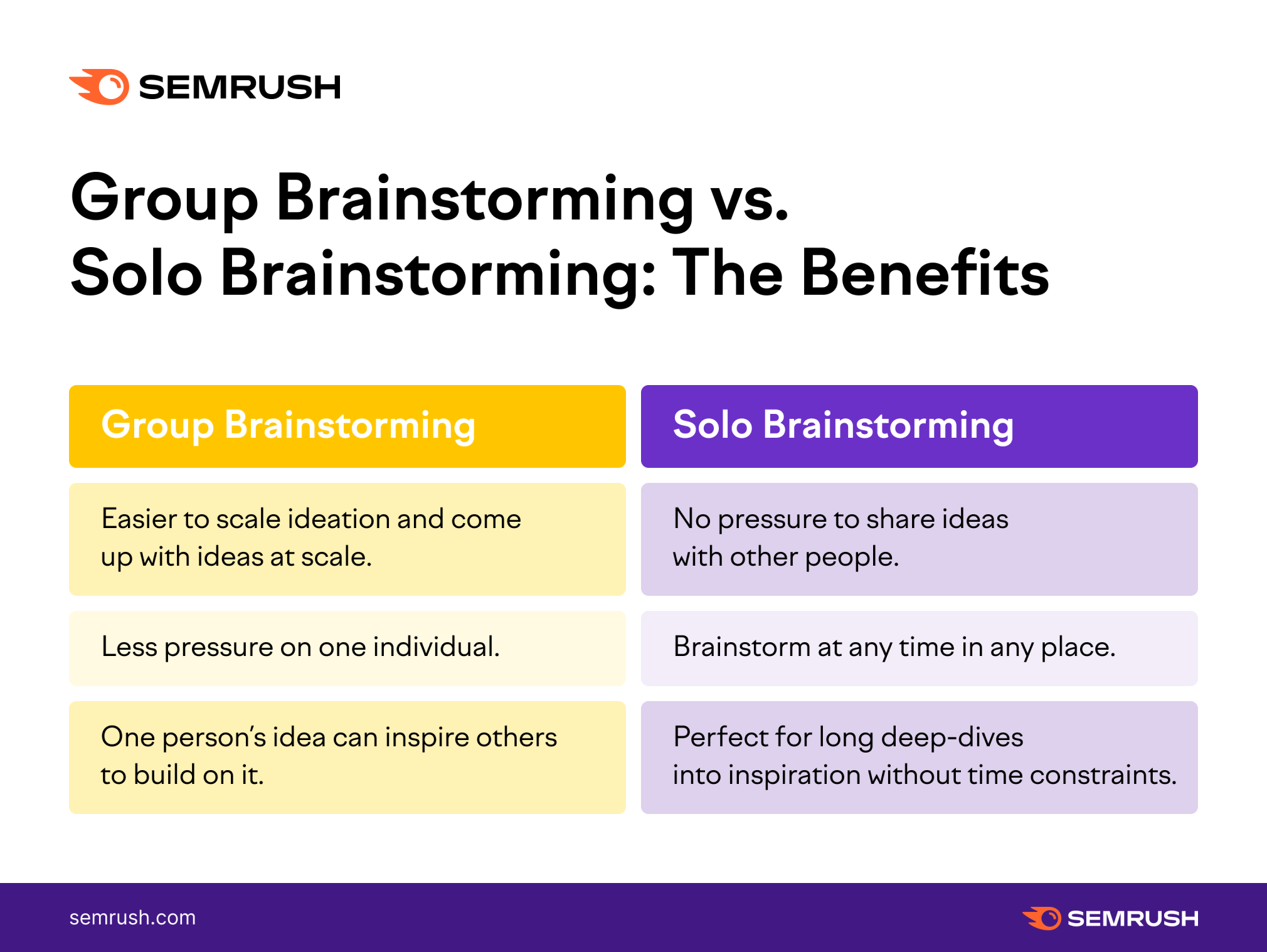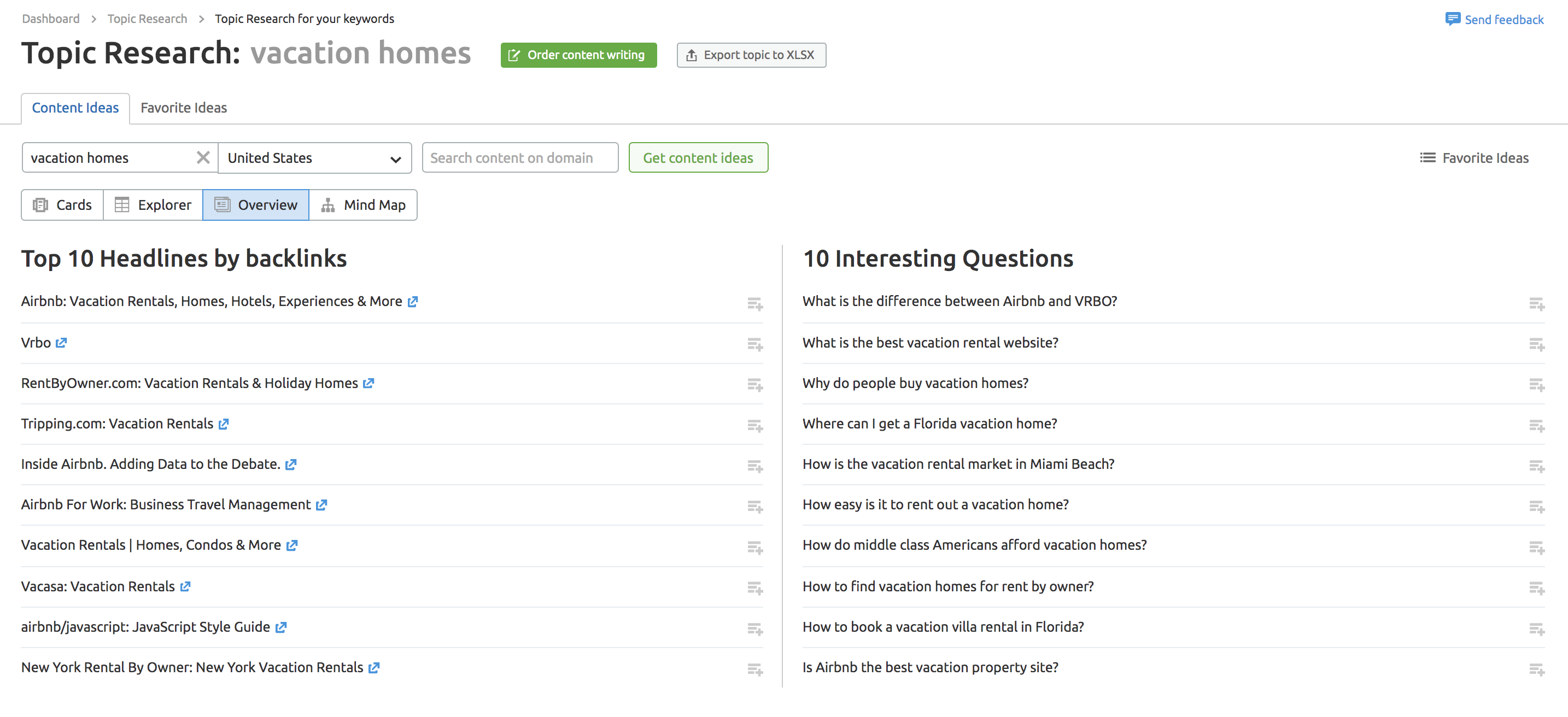Brainstorming is something that many of us have a love-hate relationship with.
It is so rewarding when you can come up with an excellent idea that is so exciting that you want to shout aloud and tell the world. But it can just as quickly feel the exact opposite when you are not able to come up with ideas.
We are all wired in different ways, and a brainstorming technique that works for one person might not be right for someone else. While it is debatable as to whether or not you can teach creativity, one thing that you absolutely can do is encourage and inspire creative thinking.
There are several different brainstorming techniques that are tried and tested and are proven to inspire creativity that we will look at here.
Use this guide to find a new approach to having better ideas when you have hit a creative block or simply try out a few different ways to see what works for you. There is no right or wrong technique, and whatever works for you is what you should use.
What Is Brainstorming and When Should You Use It?
What is brainstorming? And when might you need to use it as a marketer?
According to MindTools:
Brainstorming combines a relaxed, informal approach to problem-solving with lateral thinking. It encourages people to come up with thoughts and ideas that can, at first, seem a bit crazy. Some of these ideas can be crafted into original, creative solutions to a problem, while others can spark even more ideas. This helps to get people unstuck by 'jolting' them out of their usual ways of thinking.
Brainstorming is a proven way to come up with creative ideas or so solve a problem, either as a group or individually.
In the context of marketing, specifically in digital, this means coming up with ideas for content, whether that is to write a blog post, creating a digital PR campaign, or even creating something that people will want to share and engage with on social media.
Brainstorming is all about finding an effective way to ideate.
The Golden Rules of Effective Brainstorming
Brainstorming is not one set way of coming up with ideas. Far from it.
Instead, it merely refers to the process of using a technique to help you to come up with ideas you otherwise probably would not have had. In some ways, it can be thought of as forced creativity.
However, creativity is something that cannot be forced — especially when under pressure. For this reason, you must follow the golden rules of effective brainstorming:
The more ideas, the better. We are all used to doing more with less. But when it comes to ideation and brainstorming, the more ideas and seeds of inspiration you have, the better chance that you can turn these into something amazing. There is no such thing as a bad idea. Do not criticize other people's opinions or refrain from putting your ideas forward that you feel are week. Someone else might spot something in it that you did not and be able to build upon an idea. No idea is too big or too crazy. It is always better to have to scale back a plan that is not realistic to execute rather than struggling to scale something up. No idea is final at this stage. The best ideas come when people work together to offer their input, improve, and refine an early concept. Until this has happened, all opinions should be considered.Approach creative ideation with these in mind, and you will help to maintain a focus that does not limit your ability to let the ideas flow.
The Need for a Mindset Shift Towards Brainstorming
Effective brainstorming is all about your mindset and the way you approach it.
While some people believe that creativity is something that we are born with, anyone can be creative. Even those who do not see themselves as true creatives can come up with great ideas for content. But you need to be prepared to break out of the mold and find the brainstorming methods that work for you.
When we think of brainstorming, we automatically assume that this means a group of people sat around a whiteboard trying to come up with ideas off the top of their heads.
But this could not be further from the truth. Brainstorming can be done effectively either as a group or on your own, and this traditional approach is rarely practical.
After all, very few of us can be creative on demand...
Group Brainstorming vs. Solo Brainstorming
Group brainstorming vs. solo brainstorming. It's pretty self-explanatory, but there are right and wrong ways to approach solo and group brainstorming.
You can effectively brainstorm and come up with great ideas on your own; some people work better this way. Do not let anyone tell you otherwise.
But one of the most effective approaches for many teams is to combine the benefits and tactics of these two, starting with solo brainstorming to come up with initial ideas, then coming together as a group to refine and develop them into final concepts.

9 Brainstorming Techniques for Better Content Ideas
When you need to come up with better content ideas, you might need to try a couple of different brainstorming techniques to feel inspired and push your creativity to its limits. While you cannot force this, there are ways that you can structure your ideation to follow a process that will help.
Here are 9 of our favorite techniques that we urge you to try:
1. Mind Mapping
Mind mapping is often the starting point for all brainstorming sessions, and it can be used both for solo and group ideation.
Similar in many ways to word association, it is all about a free-flow approach that has you write down ideas, thoughts, and notes that step out from a starting point and subsequent sub-topics.
The concept is simple to understand and easy to follow:
Start with a sheet of paper, whiteboard, or an online mind mapping tool (such as Lucid Chart). Place the central topic in the very middle of the space and write your ideas around it. Draw lines out of the main topic and create at least four sub-topics (i.e., things that sit within your main topic). Extend each of these out with ideas that come to mind around these sub-topics. These could be headlines, narrower topics, interesting facts, etc. Whatever you are triggered to write.Once you have completed a mind map, give yourself a set time or work until you cannot add any more. Then, you should have a whole page (or whiteboard) of initial seed ideas to refine further into awesome content ideas.
Are you struggling to get started? Check out this excellent video walkthrough of the process.
2. The Content Swipe File
Effective ideation is all about feeling inspired to have great ideas.
When you are trying to come up with initial content ideas on your own (maybe to take into a group refinement session), one proven method is to spend time scrolling through your swipe file. It is important to note that this is not something you can just decide to try the next time you need ideas; you need to build up a content swipe file over time.
What is a content swipe file?
If you are not familiar with a swipe file, it is essentially a collection of pieces of content that you think are great and that inspire you. When you are starting to brainstorm, spend a few minutes looking (swiping) through swipe file to remind yourself of those pieces you love and think about why you find them so inspiring.
It sounds simple, but it works. It is an approach to creative ideation that many have been introduced to by Mark Johnstone, and creating your own is simple and straightforward.
You need somewhere to build a collection of content that you love. Pinterest is excellent for this, especially if you want to save visual content, but other alternatives include SwipeFile.com or simply Google Sheets. As you find fantastic content, add it to your swipe file and build up your bank of inspirational pieces. Before you start the ideation process, look through your swipe file to get those creative juices flowing.3. The Gap Analysis
There is a common misconception that content ideas have always got to be new and unique - but that is not true.
If the reason you are planning content is to create blog posts or pages to rank on the SERPs, your focus should be on identifying those key opportunities where you can add value and outrank your competitors. You do not always need to be reinventing the wheel.
And one of the most effective ways to come up with content ideas when driving organic search traffic is one of your main goals is to conduct a gap analysis.

John Reinesch wrote a great guide on how to “ Steal Your Competitors' Traffic with Content Gap Analysis” that walks you through exactly how you can do this and how you can identify keywords and content opportunities that competitors rank for, but that you do not. This guide from Zazzle dives further into this tactic, too.
A key takeaway is that brainstorming and ideation do not always need to be massively creative. Simply put, sometimes you just need to collect the right data and turn that into great ideas.
4. 6-3-5 Brainwriting
If you are keen to run brainstorming as a team but have figured out that sitting around a whiteboard having everyone share their own ideas aloud often isn't productive, give 6-3-5 brainwriting a try.
It may not be a method you have come across before, but it dates back to the 1960s, and its inception can be credited to Bernd Rohrbach, a German marketing professional. The concept of 6-3-5 brainwriting is that you work as a group of six people, all of whom are in the same room. Here's a breakdown of the process:
Provide each participant with a piece of paper that has been broken down into a grid, like this. Start the first round of ideation (lasting 5 minutes), and each person fills in 3 ideas on their sheet. After this, everyone passes their sheets to the person on their left. Each person reads the ideas from the previous person and round and uses these to be inspired to add three more ideas during the second 5-minute round. Continue this for six rounds, and then you will have a combined total of 108 ideas. Some might be the same, but that is not an issue; it is all about developing ideas and having a productive brainstorming session.These ideas can then be taken to a group discussion to refine and develop.
5. Bad Ideas First
One of the biggest criticisms that people have of group brainstorming is that participants are often hesitant to share their ideas in the worry that other people might think they are bad. Of course, there is no such thing as a bad idea when it comes to ideation. However, imposter syndrome is real, and not everyone is confident enough to share their ideas in front of others.
So why not break the ice and start by purposefully trying to come up with bad ideas?
It is a proven approach (also known as reverse brainstorming by some), and it can ease everyone into a session and help start the flow of creativity. By putting forward a round of bad ideas, you can move toward better ideas and build upon them.
It is not just in content ideation that this approach works, and this is even something that has been used by the National Gallery of Art in Washington, D.C.
But how do bad ideas lead to good ideas?
The pressure to come up with something outstanding is reduced considerably. It levels out the playing field in the room as everyone intentionally has to come up with bad ideas. It is a great way to help to build trust and confidence with individuals in a team. It creates a comfortable space for good ideas to flow.6. Browsing and Searching for Inspiration
Creative thinking often feels unproductive; this is normal.
As we mentioned above, creativity is something that cannot be forced, and it is practically impossible to come up with great ideas on demand. Even if you're trying to come up with ideas for relatively low-barrier-to-entry work such as blog content, it is still hard to come up with a brilliant idea in a matter of minutes.
So take a break from forced thinking and spend time browsing the web.
Run searches around the topic you are trying to ideate around and read news articles; turn to Google Trends to see what the current trends are and see what others are writing about or saying.
Just be sure to make notes on anything you find interesting, or that stands out. You can then take the topics and ideas you have noted one step further and turn these into solid ideas using our Topic Research Tool.
Simply enter a topic and browse through the content ideas that are returned:

7. Walking and Talking Brainstorming
It perhaps comes as no surprise that some of the best ideas we have come while we are out running, taking a shower, traveling, are in bed, or are in a similar situation.
While we cannot truly predict when we will have these ideas, we can try to replicate a low-pressure environment that can promote creative thinking. This is what we can refer to as ‘walking and talking brainstorming.’ Get out of the office and go for a walk, either as a small group or even as a larger team. This method of brainstorming is inspired by the increasingly popular concept of walking meetings. People, from Steve Jobs to Mark Zuckerberg, favor walking meets. This article claims that the reason walking and talking brainstorming meetings are so effective:
Nature and changes of scenery trigger new neuro-pathways in our brains which yield new ideas, and new solutions to problems
— Marissa Levin, Inc.com
Next time you are planning a meeting, see if you can make it a walk-and-talk brainstorming session with your team; you get the bonus of some fresh air, too!
8. Rapid Ideation
Sometimes the issues that we have when brainstorming are that we try too hard to think up ideas. So, remove this barrier.
It is as simple as working either individually or as a group, setting a timer (5 minutes works well), and writing down as many ideas as you can in that timeframe. There is no such thing as a bad idea, and even if something you write down does not relate contextually to the topic you are ideating around, then that is fine.
It is about coming up with seed ideas at scale, which you can then pick out the best ones and develop these further.
9. Competitor Analysis
Keeping an eye on the competition and knowing their every move is one of the best ways to start ideation and to brainstorm around a topic. It might sound simple, and it might not seem like a traditional brainstorming technique, but it is useful for two reasons:
Few things will inspire you to come up with excellent ideas more than a piece that performs well for a competitor. It is just how we are wired. You can learn from their mistakes and poor-performing content and work that into your own ideas. Why make a mistake yourself when you can learn what has not performed for someone else and figure out how to do something better?Which Brainstorming Technique Is Right for You?
There is no right or wrong way to do brainstorming and what works for one person might not work for another, even if they are working within the same team.
Some people work better on their own, while others will have their best ideas when brainstorming as a team. And, in many ways, using different methods across a content marketing team can be hugely effective. You can have different people come up with totally different ideas only as a result of how they approach it.
Our advice?
If you are struggling to feel inspired to come up with great ideas, try a new approach. Do not settle for what you have always done. Shake things up, do something different, and see what comes out as a result.Innovative SEO services
SEO is a patience game; no secret there. We`ll work with you to develop a Search strategy focused on producing increased traffic rankings in as early as 3-months.
A proven Allinclusive. SEO services for measuring, executing, and optimizing for Search Engine success. We say what we do and do what we say.
Our company as Semrush Agency Partner has designed a search engine optimization service that is both ethical and result-driven. We use the latest tools, strategies, and trends to help you move up in the search engines for the right keywords to get noticed by the right audience.
Today, you can schedule a Discovery call with us about your company needs.
Source:





